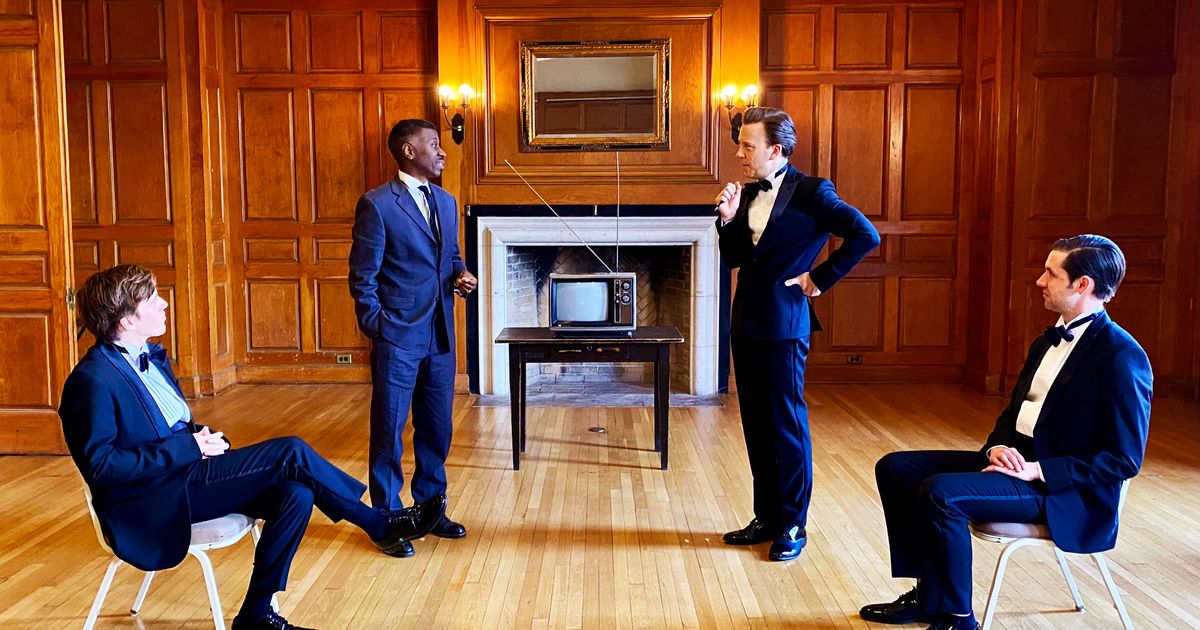From Debate: Baldwin vs. Buckley, at the South Oxford Space.
Photo: Christopher McElroen
When you jump into Off–Off Broadway, you find yourself diving through strata of density and investment. The category contains everything from the microbudget reading in a living room to shows staged by long-lived production companies that can pump money and time into the process. All four Off–Off shows I saw this week looked incredible, all handsomely set, many into unconventional spaces. They weren’t each wonderful all the way through, but they were all varieties of effortful beauty, made on different widths of shoestring.
One of the heaviest hitters in this league, The Bushwick Starr, is temporarily nowhere while its new space in Bushwick is still being built. Producing A Song of Songs by Agnes Borinsky takes the unfixed Starr to the art and social-justice group El Puente, whose Williamsburg Leadership Center is in a lovely ex-church, St. Mary of the Angels. There the audience sits on couches in the carpeted chancel, under banners (“Peace for Vieques Now!”) and amid other El Puente paintings and puppets. Borinsky’s play contains several altars and references to spiritual sustenance, so a church seems like the right spot for it, deconsecrated or not.
The play isn’t really a play. Its 70 minutes are loosely woven, with great big holes where Borinsky, director Machel Ross, and alumni from El Puente programs have placed collective rituals. These ceremonies are Sunday-school-simple — at different moments we in the audience make tissue-paper flowers to put on an altar of papier-mâché figures, or we write names on green paper leaves, then pin them to a huge, vault-spanning wreath. Between these participatory episodes, Borinsky shades in a very spare narrative. There are (barely) characters — a new couple, Nadine (Borinsky) and Sarah (Sekai Abeni), and Nadine’s cantankerous friend Trudy (Ching Valdes-Aran)— but they have only fragmentary conversations. In the script, the people are represented as numbers, which makes them seem even more like abstractions. Here, for instance, is one microscene.
1
You seem depressed.
2
Maybe.
1
I can sit with you.
2
If you want.
1
Of course I want
We can talk, too.
2
That’s alright.
I don’t really know what I would say.
Like the lovestruck Song of Songs in the Bible, Borinsky’s A Song of Songs floats in and out of dream. Her poetry isn’t quite canticle-ready — less “his countenance is as Lebanon, excellent as the cedars” and more “I’ll go wherever you go. I’ll be your dog, at your heel, you don’t have to do anything but feed me.” The idea is the same, though, in that lovers expressing personal, romantic love include larger intimations of death and faith. The deliberately amateurish production gestures at a kind of un-theater, something that’s as much community workshop as it is an entertainment. The actors’ blunt, nursery-rhyme style meshes with the project’s own rejection of theatricality and illusion: The performers act like teens at a youth-group lock-in, because that’s sort of who they are.
Borinsky’s writing seems to be in a kind of transition into weightlessness. A few years ago, her Of Government was an incredible play, relatively conventional (for a play with mermaids) and dialogically rich; other works like Brief Chronicle, Books 6-8 (i am a slow tide) handled logic more fluidly and eccentrically, yet they still contained a literary string keeping the lofty thoughts tethered. A Song of Songs cuts that cord. It’s just … floating … fragments. At one point, Borinsky breaks character to say she wanted to write a play that pushes love so far into grief that something “cracks open,” but the scenes never come close to doing something so difficult. Only when we’re told during one of the rituals to think of someone we miss does the piece actually knock at our hearts. And look, if you open to the knocking, A Song of Songs will be able to touch you. For my part, I sat clenched and reluctant on my couch. I was unwilling to hand over my own sorrows for their liturgy: I knew the show wanted them, but I wouldn’t give them up.
John J. Caswell Jr.’s Man Cave does look amazing. The horror play takes place in a rich man’s basement, and for Page 73’s customarily luxe production, set designer Adam Rigg has made a photorealistic environment, one that exactly creates the impression that the room is underground. To heighten our sense of immersion, Rigg surrounds the set with a wide black rectangle, which makes the stage picture look like a movie screen. Thanks to lighting designer Lucrecia Briceno, the images inside glow.
Caswell’s picture show, though, doesn’t quite work as it should. His scenario ought to be full of tension; it’s certainly full of rage. Imaculada (Annie Henk) is the housekeeper for an Arizona senator. She can tell there’s something creepy about his empty mansion — we first see her inching into the finished basement, listening nervously to the walls — but it can at least offer a night’s refuge to her friends, the battered Rosemary (Jacqueline Guillén) and Lupita (Claudia Acosta). Rosemary’s face, neck and arm are seriously hurt — she’s clearly got either a fractured eye socket or a broken nose — but her friends are afraid to get medical help. Rosemary’s violent boyfriend’s a cop, and she’s worried he might report her mother Consuelo (Socorro Santiago) to ICE. Rosemary therefore decides to go with option B: to call forth the spirits under the mansion, a group of long ago Hopi (she’s guessing) whose burial ground was defiled by the Republican’s TV room.
Caswell wants to make a thriller out of these elements, but horror is delicate — it’s the hardest genre to achieve on stage. You can’t just barge into a theater and start flashing the lights blue and red. The director, Taylor Reynolds, managed some exquisitely frightening touches in Plano in the same space in 2019, but here she’s stuck with overwritten ceremonies and underconceived dramatic tensions.
Nothing, not even an otherworldly growl, can stop Rosemary from holding forth on leftist talking points. Someone drops a hat, and she sounds off on colonizer culture, homophobia, climate justice, bodily autonomy. Imaculada tries to offer her some of her boss’s cash, and Rosemary rebuffs the Republican’s money. “Anti-abortion anti-immigrant anti-clean-energy buy-offs redoubled on the backs of crooked investments. Just look at Peterson’s voting record. They shouldn’t even be able to buy stock,” she says. Rosemary keeps slowing down the show, convincing us that she isn’t that much in crisis, since there’s time to worry about clean energy buy-offs. And much of the play’s action consists of some of the group wanting to do the summoning, then one person holding out, until suddenly the hold-out capitulates and someone else refuses. Perhaps it’s this schematic quality that holds the performers back — they rarely register fear, let alone urgency. (Socorro uses this unflappability as part of her comic arsenal, but where she is dryly wry, the others are blank.)
Too late, Caswell turns his attention to Imaculada, the more interesting character. She has had gastric bypass surgery, possibly to please her fatphobic employer, and as the indigenous spirits get closer, her stomach begins to shift and cramp. Clearly Caswell has a deep well of metaphorically vivid material here: the sense of flesh and landscape too long denied, a body-horror approach, and a legislator’s empty mansion where the walls keep the housekeeper under surveillance. To organize all this into a play of ratcheting tension, though, is staggeringly difficult. Rigg’s gorgeous set hints at what’s wrong — it shouldn’t just look like a film, it should be a film. Puzzled by what felt like a rare misfire from Page 73, I started reading the script. It certainly reads like a screenplay, and a hell of a one at that. Just the idea of Imaculada’s tiptoeing descent, seen from her perspective, gave me chills. Whose darkness is down there? Her own? The Senator’s? A displaced people’s? We see her go up and down those stairs a dozen times in Man Cave and don’t think anything of it. But if we were watching that stair from a camera over her shoulder — we might never sleep again.
Meanwhile, in a literal basement (the Gym at Judson Church), the theater company Mason Holdings has made Hart Island, a piece based on (and about) the city’s open wound. For a while, it seems as if the experience — there’s not enough forward motion to call it a play — is a history lesson on our topographical neighborhood. A woman in a sound booth narrates a little tour of New York’s islands, first tying them (dubiously) to Pangaea, then zooming in to give us the tragedies of Roosevelt Island (asylums and smallpox hospitals), North Brother Island (a ferryboat disaster that killed a thousand people), and finally Hart Island, still the city’s potter’s field, where Rikers Island detainees bury box after box in unmarked graves.
The show describes itself as a “theatrical multimedia meditation,” which means that it’s purely atmosphere: On Christopher and Justin Swader’s long horizontal set – an open trench that somehow smells of moist earth — director Kristjan Thor has actors amble around and murmur about abandonment. One is the man who takes the inmates out to Hart Island; another is a woman whose child is buried there; another is a nurse, whose sympathies cannot withstand COVID’s repeated assaults. Writer Tracy Weller also plays the audio narrator in the sound booth, and both her performance and her text are too full of reversions, asides, interruptions, and self-indulgent voice breaks, as she tears up over her own words. There’s much more poetry in the environment the designers have built, which really is a marvel. If you just watched Christina Tang’s lights shift over the turned earth and listen to Philip Carluzzo’s haunting sound design — the injustices of our city would be revealed (and covered and revealed again) by their dark, tidal beauty.
From A Song of Songs, at El Puente’s Williamsburg Leadership Center.
From Hart Island, at Judson Memorial Church.
From Man Cave, at the Connelly Theater.
Photographs: Luke Ohlson, Maria Baranova, Daniel Vasquez
Speaking of disinterring history, my best recommendation for you this week is actually a play made with almost nothing — just bodies, in a room, with one staticky television set occasionally playing a clip. Debate: Baldwin vs. Buckley is a verbatim piece, meaning that it’s a word-for-word replica of a real 1965 debate, hosted by the Cambridge University Union’s debating society. (Director Christopher McElroen adapted the text for his company, The American Vicarious.) After an introduction from the archival video — you can watch it yourself here —young fellows in tuxedos introduce the question before the house: whether “the American Dream is at the expense of the American Negro.” Teagle F. Bougere plays James Baldwin, arguing in the affirmative; Eric T. Miller plays William F. Buckley Jr., the conservative titan, who counters him.
You could go to theater in New York every night for a hundred years and never go to the South Oxford Space in Brooklyn. It’s an ART/New York venue, but it’s usually used for readings, rehearsals and concerts. It’s basically a parlor, with lovely paneled walls, and McElroen uses it to evoke the boundaries of politeness. We’re in a delicately made room, with men in evening dress (Baldwin wore a suit); how could anything uncouth be happening? We clearly hear, though, how such an environment allows Buckley to say awful things — to issue, in his closing, what are obviously threats. Another experimental theater company, Elevator Repair Service, is working on its own performance of this same debate; in just one turn of the theatrical season, the Baldwin/Buckley text is becoming a classic. I will be eager to compare the two Debates — how will they be different? In this case, Bougere (exhausted but on fire) makes the production unmissable. At one point, the British debaters on the TV applaud Baldwin, and he looks out at us warily, noting how different our response is. He can see for miles and miles; he knows exactly what our polite response bodes for his future.
A Song of Songs is at El Puente’s Williamsburg Leadership Center through March 27.
Man Cave is at the Connelly Theater through April 2.
Hart Island is at the Gym at Judson through April 9.
Debate: Baldwin vs. Buckley is at the South Oxford Space through April 3.













